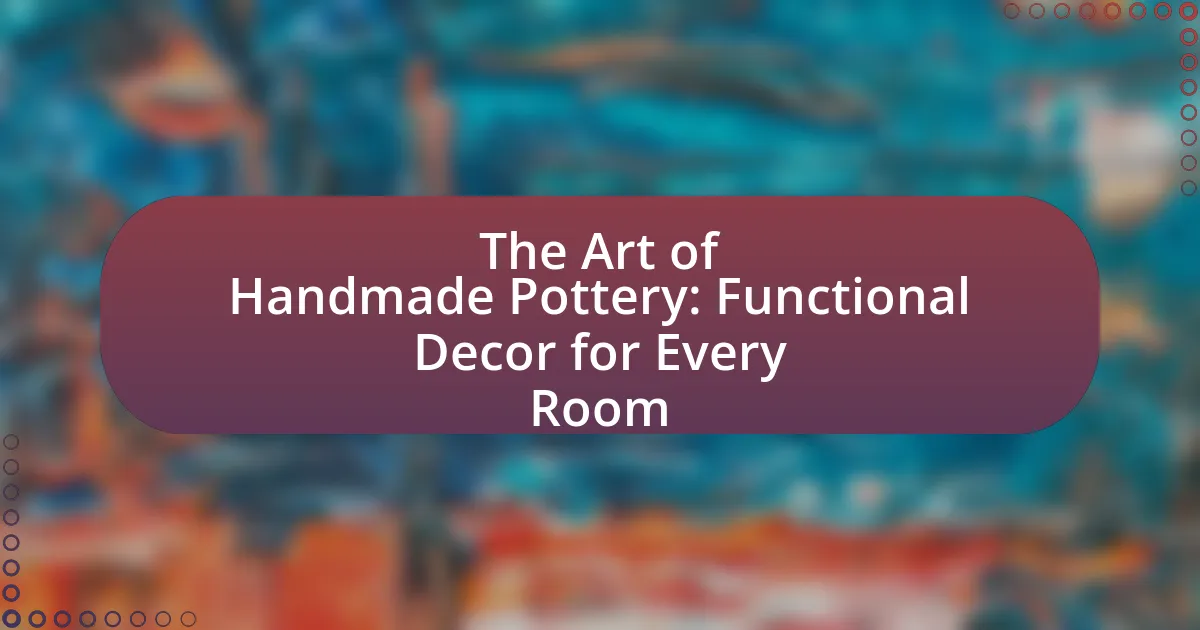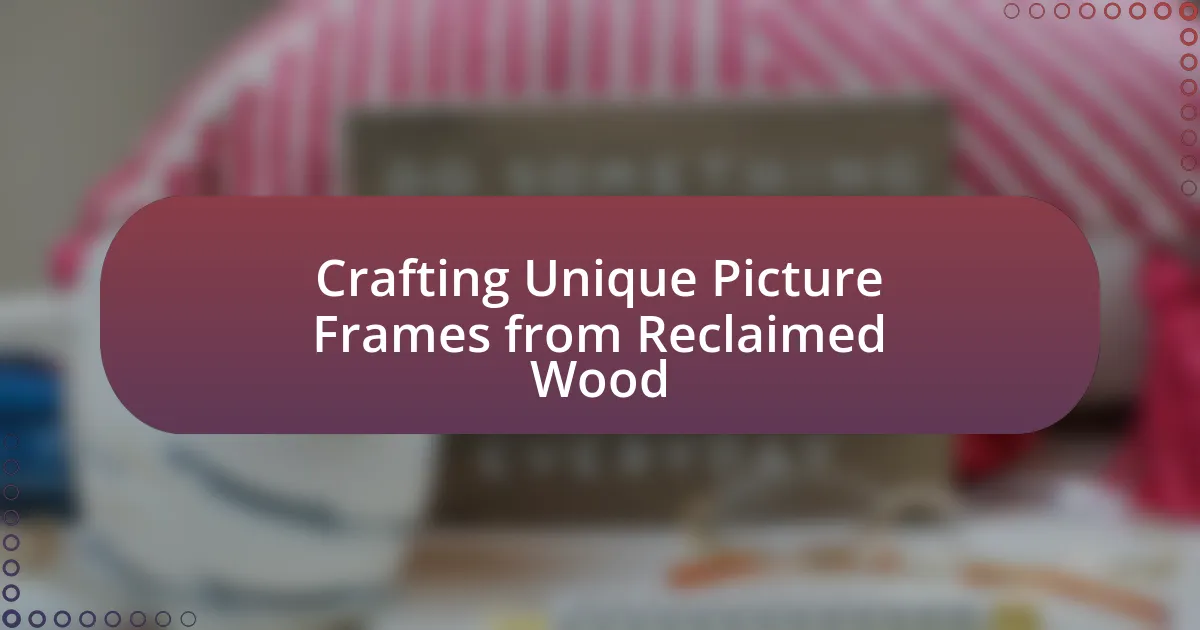Transforming old furniture with decoupage techniques involves applying decorative paper cutouts to furniture surfaces and sealing them with a protective finish, revitalizing worn pieces and allowing for personalized designs. The process includes selecting materials, preparing surfaces, and employing various techniques such as layering and tearing to enhance aesthetic appeal. Key benefits of decoupage include creative expression, increased durability, and environmental sustainability by reducing waste. Essential materials for decoupage projects include decorative paper, decoupage medium, and sealants, while proper preparation and maintenance are crucial for achieving lasting results.

What is Transforming Old Furniture with Decoupage Techniques?
Transforming old furniture with decoupage techniques involves applying decorative paper cutouts to furniture surfaces, followed by sealing them with a protective finish. This method revitalizes worn or outdated pieces, allowing for personalized designs that can reflect individual style. Decoupage has historical roots dating back to the 12th century, where it was used in various cultures to embellish objects, demonstrating its long-standing appeal and versatility in furniture restoration.
How does decoupage work in furniture transformation?
Decoupage works in furniture transformation by applying decorative paper cutouts onto surfaces and sealing them with a protective finish. This technique allows for the customization of furniture, enabling the creation of unique designs that can enhance aesthetic appeal. The process typically involves cleaning the furniture surface, selecting images or patterns, adhering them with glue, and finishing with varnish or sealant to ensure durability. Historical evidence shows that decoupage has been used since the 12th century, with its popularity peaking in the 18th century, demonstrating its long-standing effectiveness in furniture decoration.
What materials are needed for decoupage on furniture?
To perform decoupage on furniture, the essential materials needed include decorative paper or fabric, decoupage medium (such as Mod Podge), scissors, a paintbrush or sponge applicator, and a clear sealant. Decorative paper or fabric serves as the primary design element, while the decoupage medium acts as both adhesive and finish. Scissors are required for cutting the paper or fabric to the desired shapes, and a paintbrush or sponge applicator is used to apply the medium smoothly. Finally, a clear sealant provides protection and durability to the finished piece.
How do different types of paper affect the decoupage process?
Different types of paper significantly affect the decoupage process by influencing adhesion, texture, and durability. For instance, tissue paper is lightweight and easily conforms to surfaces, making it ideal for intricate designs but may require careful handling to avoid tearing. In contrast, cardstock offers sturdiness and vibrant colors, allowing for bold designs but may not adhere as seamlessly to curved surfaces. Additionally, specialty papers like rice paper provide a translucent quality that enhances layering effects, while scrapbook paper often features patterns that can add depth. Each paper type’s unique characteristics dictate the techniques used, such as layering, sealing, and finishing, ultimately impacting the final appearance and longevity of the decoupage project.
What are the benefits of using decoupage on old furniture?
Using decoupage on old furniture revitalizes and enhances its aesthetic appeal while providing a protective layer. This technique allows for creative expression, enabling individuals to personalize their furniture with unique designs and patterns. Additionally, decoupage can increase the furniture’s longevity by sealing surfaces against wear and moisture, thus preserving the underlying material. Studies indicate that upcycling methods like decoupage can significantly reduce waste, contributing to environmental sustainability by extending the life of furniture items rather than discarding them.
How does decoupage enhance the aesthetic appeal of furniture?
Decoupage enhances the aesthetic appeal of furniture by allowing for the application of intricate designs and patterns that can transform ordinary pieces into visually striking focal points. This technique involves adhering decorative paper or fabric to surfaces, which can introduce color, texture, and artistic elements that reflect personal style. Historical evidence shows that decoupage has been used since the 12th century, with artisans employing it to create elaborate designs on furniture, thereby increasing its visual interest and value. By customizing furniture through decoupage, individuals can achieve a unique look that aligns with contemporary trends or personal tastes, making the furniture not only functional but also a work of art.
What environmental benefits does transforming old furniture provide?
Transforming old furniture provides significant environmental benefits, primarily by reducing waste and conserving resources. When furniture is repurposed, it diverts materials from landfills, thereby decreasing the volume of waste generated. According to the Environmental Protection Agency, furniture accounts for a substantial portion of municipal solid waste, and reusing or recycling these items can significantly lower this impact. Additionally, transforming old furniture minimizes the demand for new materials, which in turn reduces the environmental footprint associated with manufacturing processes, such as deforestation and energy consumption. This practice promotes sustainability by extending the lifecycle of existing products and encouraging a circular economy.

What steps are involved in the decoupage process?
The decoupage process involves several key steps: selecting materials, preparing the surface, cutting images, applying adhesive, layering images, sealing, and finishing. First, individuals choose decorative paper or images that will be used for the project. Next, the surface of the furniture is cleaned and primed if necessary to ensure proper adhesion. After preparing the surface, the selected images are cut out carefully. Then, a decoupage medium or adhesive is applied to the surface, followed by placing the cut images onto the adhesive. Additional layers of images can be added, with more adhesive applied on top to secure them. Finally, a sealant is applied to protect the finished piece, ensuring durability and enhancing the appearance. Each of these steps is crucial for achieving a successful decoupage result on old furniture.
How do you prepare old furniture for decoupage?
To prepare old furniture for decoupage, first clean the surface thoroughly to remove dust, grease, and old finishes. This ensures proper adhesion of the decoupage materials. Next, sand the furniture lightly to create a smooth surface and help the decoupage medium adhere better. After sanding, wipe down the furniture with a damp cloth to remove any dust particles. If the furniture has any imperfections, fill them with wood filler and sand again once dry. Finally, apply a primer or base coat if necessary, especially for darker surfaces, to enhance the vibrancy of the decoupage materials. This preparation process is essential for achieving a durable and visually appealing finish.
What cleaning methods are effective for preparing furniture?
Effective cleaning methods for preparing furniture include dusting, vacuuming, and using appropriate cleaning solutions. Dusting removes surface dirt and debris, while vacuuming can eliminate dust from crevices and upholstery. For deeper cleaning, a mixture of mild soap and water or specialized furniture cleaners can be applied with a soft cloth to avoid damage. These methods ensure that the surface is clean and ready for further treatment, such as decoupage, by removing contaminants that could interfere with adhesion.
How do you choose the right surface for decoupage?
To choose the right surface for decoupage, select a material that is smooth, clean, and non-porous, such as wood, metal, glass, or ceramic. These surfaces allow for better adhesion of the decoupage medium and ensure a more durable finish. For instance, wood surfaces should be sanded and primed if necessary to create an ideal base, while glass and metal may require a specific adhesive to ensure the decoupage elements adhere properly.
What techniques can be used in decoupage?
Decoupage techniques include layering, tearing, and using different adhesives. Layering involves applying multiple pieces of paper or fabric to create depth, while tearing allows for a more organic edge that blends better with the surface. Different adhesives, such as Mod Podge or PVA glue, can be used to secure the materials and provide a protective finish. These techniques enhance the aesthetic appeal of furniture by allowing for customization and creativity in design.
How do layering techniques impact the final look of decoupage?
Layering techniques significantly enhance the final look of decoupage by adding depth, texture, and visual interest. Each layer contributes to a more complex and rich appearance, allowing for variations in color and pattern that can transform a simple design into a striking piece. For instance, applying multiple layers of paper or varnish can create a three-dimensional effect, making the artwork appear more dynamic and engaging. Additionally, the use of different materials in each layer, such as fabric or textured paper, can further enrich the visual experience, leading to a unique and personalized finish that reflects the creator’s style.
What are some common mistakes to avoid during decoupage?
Common mistakes to avoid during decoupage include using the wrong type of glue, applying too much or too little adhesive, and neglecting to prepare the surface properly. Using a glue that is not suitable for decoupage can lead to poor adhesion and damage to the materials. Applying excessive adhesive can cause wrinkling and bubbling, while insufficient adhesive may result in peeling. Additionally, failing to clean and sand the surface can prevent the decoupage from adhering effectively, compromising the overall finish. Proper preparation and technique are essential for achieving a successful decoupage project.

What are some creative ideas for decoupaging old furniture?
Some creative ideas for decoupaging old furniture include using patterned paper, fabric scraps, or vintage book pages to create unique designs. For instance, applying floral or geometric patterned paper to a dresser can instantly modernize its appearance. Additionally, using fabric scraps allows for a textured finish, which can enhance the tactile quality of the furniture. Vintage book pages can add a nostalgic touch, making a side table or chair a conversation piece. Layering different materials and incorporating a clear sealant can protect the surface while enhancing the overall aesthetic. These techniques not only revitalize old furniture but also allow for personal expression and customization.
How can you incorporate different themes into decoupage projects?
To incorporate different themes into decoupage projects, select a cohesive set of materials that reflect the desired theme, such as floral patterns for a garden theme or vintage images for a retro theme. This approach allows for a unified aesthetic that enhances the overall design. For instance, using botanical prints alongside natural textures can create a harmonious nature-inspired look. Additionally, layering images and textures relevant to the chosen theme can add depth and interest, making the project visually appealing. The effectiveness of this method is supported by the practice of thematic consistency in design, which is known to improve visual coherence and audience engagement.
What seasonal or holiday themes work well with decoupage?
Seasonal and holiday themes that work well with decoupage include Christmas, Halloween, Thanksgiving, and springtime themes. For instance, Christmas decoupage often features motifs like snowflakes, ornaments, and festive colors, while Halloween decoupage incorporates pumpkins, ghosts, and spooky imagery. Thanksgiving themes typically showcase autumn leaves, turkeys, and harvest elements, and springtime decoupage can highlight flowers, bunnies, and pastel colors. These themes are popular because they resonate with the emotions and aesthetics associated with each season or holiday, making them ideal for transforming old furniture into seasonal decor.
How can personal photos be used in decoupage designs?
Personal photos can be used in decoupage designs by printing them on suitable paper and adhering them to surfaces with decoupage medium. This technique allows individuals to personalize furniture and decor items, creating unique pieces that reflect personal memories or themes. The process involves selecting high-quality images, cutting them to desired shapes, and applying layers of decoupage glue to ensure durability and a smooth finish. This method not only enhances the aesthetic appeal of old furniture but also preserves cherished moments in a creative way.
What are some tips for maintaining decoupaged furniture?
To maintain decoupaged furniture, regularly clean it with a soft, damp cloth to avoid damaging the surface. This prevents dust and grime buildup that can affect the appearance and longevity of the decoupage. Additionally, avoid using harsh chemicals or abrasive materials, as they can strip the finish and damage the paper layers. Applying a clear sealant every few years can also protect the decoupage from moisture and wear, ensuring that the design remains vibrant and intact. Regular inspections for any signs of peeling or damage allow for timely repairs, which can prolong the life of the furniture.
How can you protect decoupaged surfaces from wear and tear?
To protect decoupaged surfaces from wear and tear, apply a clear sealant or varnish specifically designed for decoupage. This protective layer creates a barrier against moisture, dirt, and scratches, significantly extending the life of the decoupaged item. For instance, using a water-based polyurethane sealant can provide durability and resistance to yellowing, ensuring that the colors and patterns remain vibrant over time. Additionally, regularly cleaning the surface with a soft, damp cloth can help maintain its appearance and prevent damage.
What cleaning methods are safe for decoupaged furniture?
Safe cleaning methods for decoupaged furniture include using a soft, damp cloth and a mild soap solution. These methods prevent damage to the decoupage layer while effectively removing dirt and grime. Avoid harsh chemicals, abrasive cleaners, or excessive water, as these can cause the decoupage to peel or warp. Regular dusting with a microfiber cloth also helps maintain the appearance without risking damage.
What resources are available for learning more about decoupage?
Books, online courses, and video tutorials are valuable resources for learning more about decoupage. Notable books include “Decoupage Made Easy” by Julie McCullough, which provides step-by-step instructions and project ideas. Online platforms like Skillshare and Udemy offer courses specifically focused on decoupage techniques, allowing learners to engage with the material interactively. Additionally, YouTube hosts numerous video tutorials that visually demonstrate various decoupage methods, making it easier for beginners to grasp the concepts. These resources collectively provide comprehensive knowledge and practical skills for anyone interested in mastering decoupage.
Where can you find tutorials and workshops on decoupage techniques?
You can find tutorials and workshops on decoupage techniques at various online platforms and local craft stores. Websites like YouTube offer numerous video tutorials that demonstrate decoupage methods, while platforms such as Skillshare and Udemy provide structured courses. Additionally, local craft stores often host in-person workshops where experienced instructors teach decoupage skills. These resources are widely recognized for their comprehensive content and practical guidance, making them reliable options for learning decoupage techniques.
What books or online courses are recommended for beginners?
For beginners interested in transforming old furniture with decoupage techniques, “Decoupage 101: The Basics” by Jennifer McGuire is highly recommended. This book provides foundational knowledge and step-by-step instructions tailored for novices. Additionally, the online course “Decoupage for Beginners” on platforms like Skillshare offers practical video tutorials that guide users through various projects, enhancing their skills effectively. Both resources are well-reviewed and widely recognized in the crafting community, making them suitable for those starting in decoupage.





